Retirement Plans
-
 10-PAGE WRITTEN DETAILED EXPLANATION (With 10 Useful Examples and Many Practical Planning Tips): The SECURE Act: A Retirement Plan Distribution Game-Changer$19.00
10-PAGE WRITTEN DETAILED EXPLANATION (With 10 Useful Examples and Many Practical Planning Tips): The SECURE Act: A Retirement Plan Distribution Game-Changer$19.00To assist you in understanding the SECURE Act, Mr. Siegel has written this expanded 10-page explanation which includes the following:
Learn More
- Major Changes in Rules Allowing Stretch IRAs
- The New Beneficiary Category – The Eligible Designated Beneficiary
- Important Planning Note for Disabled and Chronically Ill Beneficiaries
- Other Beneficiaries – Not Characterized as Eligible Designated Beneficiaries
- Conduit Trusts
- Accumulation Trusts
- What Needs To Change?
- Planning Alternatives -
 5-PAGE WRITTEN GENERAL EXPLANATION: The SECURE Act: A Retirement Plan Distribution Game-Changer$0.00
5-PAGE WRITTEN GENERAL EXPLANATION: The SECURE Act: A Retirement Plan Distribution Game-Changer$0.00FREE FORMS: In order to obtain this Free Form, please:
1. click the above "Add To Cart"
2. proceed with Checkout and then
3. if you already have an account, merely login or if you do not yet have an account, just create an account.
You do NOT need to enter any credit card information unless you are purchasing other forms.The SECURE Act (Setting Every Community Up for Retirement Enhancement) was signed into law on December 20, 2019, and is effective for deaths occurring in 2020 and beyond. To assist you in understanding the SECURE Act, Mr. Siegel has written this useful 5-page explanation.Learn More -
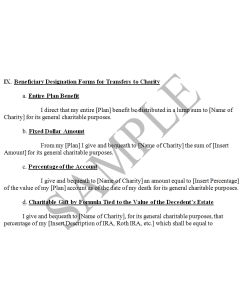 Beneficiary Designation Form for Transfers to Charity (1 Page)$29.00
Beneficiary Designation Form for Transfers to Charity (1 Page)$29.00This Form provides several alternative beneficiary designations for charities. Since retirement plan benefits are generally subject to both income tax and estate tax, they are excellent choices to be used to satisfy the charitable goals of a plan participant. In the Alternative a, b, and c designations below, a simple statement designating either the entire plan, a fixed dollar amount from the plan or a percentage of the plan balance as of date of death as the amount payable to charity is all that is necessary. Alternative d. makes reference to the charitable gift from the Plan being a percentage of the participant’s estate. Plan administrators may be wary of this designation, as it requires them to utilize information which is not part of the Plan, hence the indemnification language allowing the administrator to rely on the information provided by the representative of the decedent’s estate.
Learn More -
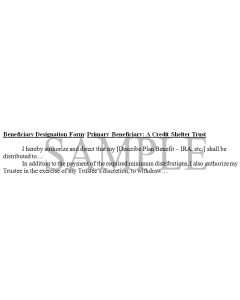 Beneficiary Designation Form: Primary Beneficiary: A Credit Shelter Trust (1 Page)$29.00
Beneficiary Designation Form: Primary Beneficiary: A Credit Shelter Trust (1 Page)$29.00This Form designates the credit shelter trust as the primary beneficiary of a Plan. It may be used in situations where the marital share of an estate plan is already being funded with other property and optimal estate tax planning suggests that the credit shelter trust be the beneficiary of the retirement plan assets. It may also be used in the case of a “blended family” where the spouse is viewed as one of, but not necessarily the only primary beneficiary and it is desired to create a more immediate benefit for children or other heirs. The participant’s credit shelter trust should be cross-referenced here.
Learn More -
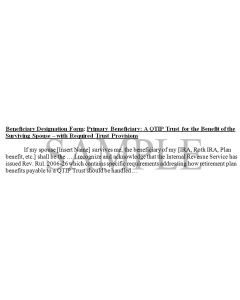 Beneficiary Designation Form: Primary Beneficiary: A QTIP Trust for the Benefit of the Surviving Spouse – with Required Trust Provisions (3 Pages)$29.00
Beneficiary Designation Form: Primary Beneficiary: A QTIP Trust for the Benefit of the Surviving Spouse – with Required Trust Provisions (3 Pages)$29.00This Form designates a QTIP Trust for the surviving spouse as the Plan beneficiary. Due to Rev. Rul 2006-26, there are a number of issues to be addressed here. While the Beneficiary Designation Form itself is relatively simple, naming the QTIP Trust as the Plan beneficiary, there are a number of required provisions that must be included in the QTIP Trust itself to assure that the participant will achieve the desired result with respect to this designation. The provisions that must be incorporated in the QTIP Trust are also a part of this Form. The term “income” must be specifically defined to comply with Rev. Rul. 2006-26. The spouse must have the right to require the trust property to be made “productive”. There must be a requirement for not less than the required minimum distribution to be paid to the trust annually. A QTIP election must be made for both the Plan and the Trust. All of these provisions are included below.
Learn More -
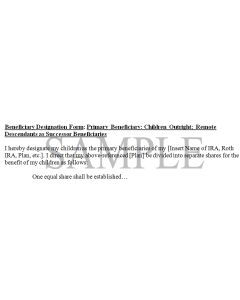 Beneficiary Designation Form: Primary Beneficiary: Children Outright; Remote Descendants as Successor Beneficiaries (1 Page)$29.00
Beneficiary Designation Form: Primary Beneficiary: Children Outright; Remote Descendants as Successor Beneficiaries (1 Page)$29.00This Form directs the Plan benefit to be divided into separate shares for the participant’s children, and such shares to be paid outright to such children. If a child does not survive the participant, the Plan benefit passes to the descendants of a deceased child by right of representation – also outright. If desired here, the draftsman can add additional provisions for either trusts or custodian accounts for younger and/or disabled beneficiaries.
Learn More
-
 Beneficiary Designation Form: Primary Beneficiary: Spouse Outright; Possible Disclaimer Options – Either Outright To Children, In Favor Of A Family Trust; Or To A Trust Solely For The Benefit Of Children$29.00
Beneficiary Designation Form: Primary Beneficiary: Spouse Outright; Possible Disclaimer Options – Either Outright To Children, In Favor Of A Family Trust; Or To A Trust Solely For The Benefit Of Children$29.00This Form begins by leaving the Plan benefit outright to the surviving spouse. If the spouse accepts this designation, nothing further need be done. However, this Form also provides that should the surviving spouse disclaim all or any part of the Plan benefit, such disclaimed benefit passes to children outright. In the event the option of a disclaimer is desired, but the outright disposition to children is not desired, Alternative 1 provides that the Plan benefit shall pass to a Family Trust. The surviving spouse may be a beneficiary of a Family Trust, and the decedent’s Family Trust should be cross-referenced here. If, instead, it is desired that the disclaimer by the surviving spouse lead to a trust that is solely for the benefit of children, then Alternative 2 should be used. Alternative 2A directs the Plan benefit to a Trust already created by the participant; Alternative 2B provides for the creation of such a Trust. In Alternative 2A the appropriate cross-reference should be made; in Alternative 2B additional trust provisions, as desired, may be added. Note the inclusion of required minimum distribution directions in all discussions of payments to trusts.
Learn More -
 Beneficiary Designation Form: Primary Beneficiary: Spouse Outright; Secondary Beneficiary: Children Outright (1 Page)$29.00
Beneficiary Designation Form: Primary Beneficiary: Spouse Outright; Secondary Beneficiary: Children Outright (1 Page)$29.00This is a basic form by which the plan participant names the surviving spouse as the outright plan beneficiary. This gives the surviving spouse the option to roll over the plan benefit to the spouse’s own IRA. If the spouse does not survive, this Form provides for an outright distribution to the children or to the descendants of any children who do not survive the participant.
Learn More -
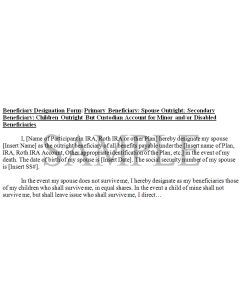 Beneficiary Designation Form: Primary Beneficiary: Spouse Outright; Secondary Beneficiary: Children Outright But Custodian Account for Minor and/or Disabled Beneficiaries (2 Pages)$29.00
Beneficiary Designation Form: Primary Beneficiary: Spouse Outright; Secondary Beneficiary: Children Outright But Custodian Account for Minor and/or Disabled Beneficiaries (2 Pages)$29.00This Form provides for an outright disposition of the Plan benefit to the surviving spouse. If there is no surviving spouse, the Plan benefit passes to children and other descendants (by right of representation) outright. However, if a child or more remote descendant has not yet reached age 21, the Plan benefit is directed to be held by a custodian for the beneficiary under the appropriate Minors’ Act. If a beneficiary is disabled, the Plan benefit may continue to be held for the disabled person by the decedent’s legal representative. (The draftsman may wish to insert more specific directions as to the management of a disabled beneficiary’s interest here – temporary arrangement, special needs trust, etc.)
Learn More -
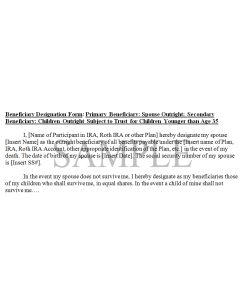 Beneficiary Designation Form: Primary Beneficiary: Spouse Outright; Secondary Beneficiary: Children Outright Subject to Trust for Children Younger than Age 35 (2 Pages)$29.00
Beneficiary Designation Form: Primary Beneficiary: Spouse Outright; Secondary Beneficiary: Children Outright Subject to Trust for Children Younger than Age 35 (2 Pages)$29.00This Form provides for an outright disposition of the Plan benefit to the surviving spouse. If there is no surviving spouse, the Plan benefit passes to children and other descendants (by right of representation) outright. However, if any child or other descendant has not yet reached age thirty-five, the Plan benefit is directed to be paid to a Trust for the benefit of any person under age thirty-five until that age is reached. The Form provides for two alternative dispositions here – the first to a Trust already created by the participant’s planning (insert an appropriate cross-reference here) - the second alternative establishes a Trust intended to continue until age thirty-five is reached (insert the name of the trustee, a possible successor, and any other desired trust terms here). Note that in both alternatives, the trustee is instructed to comply with the rules addressing required minimum distributions.
Learn More
